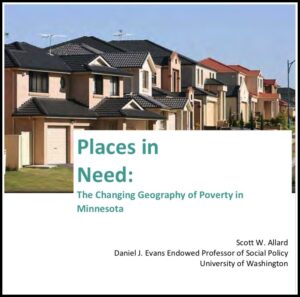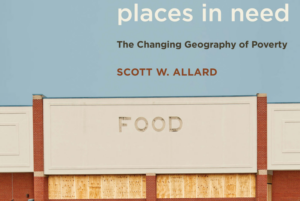 Think Small’s mission as a nonprofit is to advance quality care and education of children in their crucial early years. We do this by preparing providers, strengthening families and catalyzing change. At the center of our efforts is a focus on data, and using what we learn from that data, to transform our work in the early learning field.
Think Small’s mission as a nonprofit is to advance quality care and education of children in their crucial early years. We do this by preparing providers, strengthening families and catalyzing change. At the center of our efforts is a focus on data, and using what we learn from that data, to transform our work in the early learning field.
We recently sat down with Barbara Yates, President and CEO of Think Small, to discuss data from a research brief she received while attending a Practice and Policy summit this past spring in Minneapolis. One of the presenters was Scott W. Allard, a professor of public policy at the University of Washington’s Daniel J. Evans School of Public Policy and Governance. The brief came from his book, Places in Need: The Changing Geography of Poverty in America, which focuses on the changing geography of poverty within metropolitan America and which aspects of the contemporary safety net respond well to these changes. Data presented by Allard showed that by 2014, there were nearly 17 million poor persons living in the suburbs of the largest 100 metropolitan areas, compared to just under 13 million in cities. The rise of suburban poverty in America, however, has not coincided with a decrease in poverty in major metropolitan areas. Allard said poverty remains a serious problem in most cities.
Yates immediately began to question what kind of implications the information would have on the state’s nonprofits, but more specifically, the work of Think Small. It was clear to her that the data described, which shows that poverty rates have increased dramatically in suburbs over the last 20 years, needed to be shared with other advocates and organizations, and must also be considered as Think Small develops its new five-year strategic plan.
Q. How would you summarize the findings?
A. The most significant thing in the brief has to do with the observation that poverty in the suburbs has increased to the point that it’s greater than poverty in the urban core in Minnesota. It raises questions about the interconnections between place, poverty, and the safety net for families – do we have nonprofits and services funded and experienced with safety net issues. It’s again important to note, poverty is not going down in the urban core, it’s just that the increase of people in poverty is much higher in the suburban areas.
Q. You shared this information with members of Think Small’s Executive Leadership Team (ELT).Why and what was the reaction?
A. I was surprised by the data, or maybe I had never thought about it that way before, but some of it was surprise, and that made me wonder what does that mean about how we do our work. What is the impact on child care programs and the families they serve? Are resources equitably distributed to poor families in the suburbs? Are staff trained in issues of equity and bias? What kinds of things should we be thinking about? What does that mean about how we do policy? Everyone else had a reaction similar to what I did. The surprise is the growth of poverty in the suburban areas, and that the sheer numbers now exceed those in the urban core. There have always been people in poverty who live in the suburbs, but those numbers have been on a steep increase after the economic down turn in 2008.
One of the things that we talked about is what causes this. An ELT member mentioned it could be related to how we do housing. Where we are building housing, and specifically where we are building affordable housing? Sometimes that’s just because there is space. It’s where there is an opportunity to build. So that may be a piece of what’s going on.
Q. Why is it important to make people aware of this data? And how do we use it?
A. We want to educate people and let them know about these findings. It’s important that our partners in government, and our partners in the philanthropic community, know that it’s occurring so that they will engage with us, and others, in conversation about the limited resources and what is the best way to deploy them.
I think one point we should take from the article is that we may not have resources and programs in the suburbs that are set up to deal with the kind of poverty that we are seeing there. If you look philanthropically, we often concentrate our resources much more towards the urban poor than those in the suburbs for all kinds of reasons.
Q. How do the findings relate to early childhood education?
A. We need to talk with our staff, and with the families and providers that we serve, about this information. What are they seeing? How is this playing out in the suburbs?
It’s even looking at where we see the focus for early learning scholarships. We know we don’t have enough to serve everyone, but are we broadly getting those out? For example, we partner with Northside Achievement Zone in Minneapolis which wraps up all kinds of services for families. What if the support services aren’t the same or don’t even exist in the suburban areas? What then? What kind of burden is that putting on child care? What kind of burden is it putting on families and what kind of supports are available? A big piece of it is understanding what the data means, and then talking to people to test it out. How does that look? Is this an area where we’re not serving the best we could? How can we re-direct our resources?
Some of it has to do with is looking at what are the demographics of who is making up the families in poverty in the suburbs. What kinds of programs are available? Is the poverty more hidden? In the urban core when we’re dealing with certain issues, we can often go by zip code or by neighborhood and really focus our efforts there because we know that poverty is extremely high or concentrated. In suburban areas, it may be more dispersed because of a wider geography. So, what does it mean? How does it look like? What kinds of programs are available? We have more centers in the suburban areas. Centers are more expensive. What does that mean for families? How does that impact them? Does it mean they’re using more family, friend and neighbor care to patch things together or does it mean they’re going in serious debt? We want to know what kind of family child care is available and where is it available. We worked really hard in Minneapolis and St. Paul to make sure that we had a diverse range of programs available. In order to address families’ needs for having cultural options, we targeted our resources and focused on getting and keeping diverse providers in high-quality programs in Minneapolis and St. Paul. Maybe now, we need to look at doing some of that focused work in the suburbs. However, I think we need to be mindful of the providers there and know that their work may look very different which means we really need to use this opportunity to engage in conversation.
Q. More specifically, how does the relate to Think Small’s work?
A. The population goal that we’re looking to meet in our new strategic plan, which was set by the Board of Directors, is to ensure that all children are ready for kindergarten. And for us then that means a particular focus on those children that are in the opportunity gaps, or what some call the achievement gap. A good descriptor of that is income. You can fall into such a gap for other reasons, but a large percentage of children, if they are low income, will be at a much higher risk of falling into opportunity gaps. For us, that’s exactly the work that we’re trying to do, and where we focus our efforts. Understanding this data is very important to make sure we are providing services to ensure that children will be ready for kindergarten across the 7-county metro area.
Read the Research Brief provided by the Future Services Institute:
Places in Need: The Changing Geography of Poverty in Minneosta
 For more information about Scott Allard’s book, Places in Need: The Changing Geography of Poverty (2017, Russell Sage Foundation Press), visit HERE.
For more information about Scott Allard’s book, Places in Need: The Changing Geography of Poverty (2017, Russell Sage Foundation Press), visit HERE.








